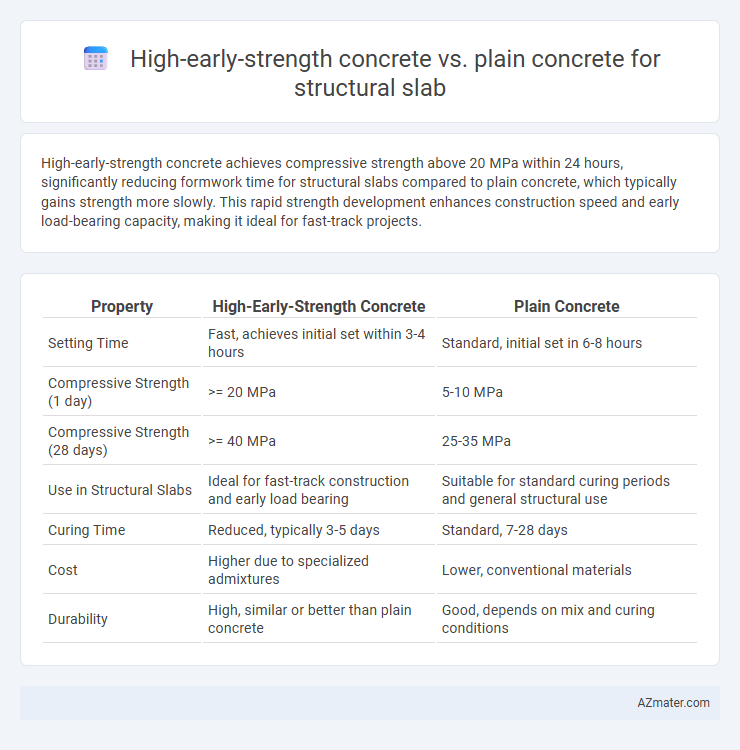High-early-strength concrete achieves compressive strength above 20 MPa within 24 hours, significantly reducing formwork time for structural slabs compared to plain concrete, which typically gains strength more slowly. This rapid strength development enhances construction speed and early load-bearing capacity, making it ideal for fast-track projects.
Table of Comparison
| Property | High-Early-Strength Concrete | Plain Concrete |
|---|---|---|
| Setting Time | Fast, achieves initial set within 3-4 hours | Standard, initial set in 6-8 hours |
| Compressive Strength (1 day) | >= 20 MPa | 5-10 MPa |
| Compressive Strength (28 days) | >= 40 MPa | 25-35 MPa |
| Use in Structural Slabs | Ideal for fast-track construction and early load bearing | Suitable for standard curing periods and general structural use |
| Curing Time | Reduced, typically 3-5 days | Standard, 7-28 days |
| Cost | Higher due to specialized admixtures | Lower, conventional materials |
| Durability | High, similar or better than plain concrete | Good, depends on mix and curing conditions |
Introduction to Structural Slabs
Structural slabs serve as essential load-bearing elements in buildings, distributing weight evenly across supporting structures. High-early-strength concrete accelerates construction timelines by achieving required strength rapidly, enhancing project efficiency and reducing formwork duration. Plain concrete, while cost-effective and widely used, requires longer curing times, potentially delaying structural progression in slab applications.
Overview of High-Early-Strength Concrete
High-early-strength concrete achieves compressive strengths exceeding 20 MPa within 24 hours, significantly accelerating construction schedules compared to plain concrete, which typically takes 28 days to reach design strength. This type of concrete utilizes specialized cement blends and admixtures that promote rapid hydration and strength development, making it ideal for structural slabs requiring early load-bearing capacity. Its application reduces formwork time and enhances construction efficiency while maintaining durability and performance standards.
Key Properties of Plain Concrete
Plain concrete for structural slabs exhibits moderate compressive strength and longer curing times compared to high-early-strength concrete, making it suitable for applications with less time sensitivity. Its workability, durability, and cost-effectiveness ensure reliable performance in standard load-bearing scenarios without the need for rapid strength gain. Plain concrete's lower initial strength development requires extended curing, which affects construction schedules but promotes long-term structural integrity and resistance to environmental factors.
Comparative Strength Development
High-early-strength concrete achieves compressive strengths of 20-30 MPa within 24 hours, enabling faster formwork removal and accelerated construction schedules compared to plain concrete, which typically develops similar strength levels only after 7 days. The rapid strength gain of high-early-strength concrete results from a higher cementitious content and optimized chemical admixtures, facilitating early load application and minimizing delays in structural slab construction. Plain concrete exhibits a more gradual strength development curve, reaching design strength around 28 days, which may extend project timelines but generally offers improved long-term durability and reduced cracking risks.
Construction Speed and Scheduling
High-early-strength concrete significantly accelerates construction speed by achieving required strength in 24-48 hours compared to 7-28 days for plain concrete, enabling earlier formwork removal and faster slab turnover. This rapid strength gain minimizes project downtime and facilitates tighter scheduling, critical for meeting accelerated timelines in structural slab construction. Contractors benefit from improved workflow efficiency and reduced labor costs by integrating high-early-strength concrete into their project schedules.
Durability and Longevity Analysis
High-early-strength concrete significantly enhances the durability and longevity of structural slabs by rapidly achieving its design strength, which minimizes early-age cracking and reduces exposure to harmful environmental conditions. Its dense microstructure improves resistance to chemical attacks, freeze-thaw cycles, and abrasion compared to plain concrete, leading to extended service life and reduced maintenance costs. Plain concrete, with slower strength gain, is more susceptible to early damage and deterioration, making it less favorable for structures demanding long-term durability.
Cost Implications and Budget Considerations
High-early-strength concrete accelerates project timelines by achieving greater strength within 24 hours, reducing formwork and labor costs, though it carries a higher initial material price compared to plain concrete. Plain concrete, being less expensive upfront, may increase overall costs due to extended curing periods and delayed construction schedules, impacting labor and overhead expenses. Budget planning must weigh the trade-off between faster project completion with premium materials and lower material costs with longer construction durations for structural slabs.
Application Scenarios and Suitability
High-early-strength concrete is ideal for structural slabs requiring rapid load-bearing capacity, such as in fast-track construction projects, emergency repairs, or precast elements where early formwork removal accelerates the schedule. Plain concrete suits applications where extended curing time is acceptable, such as residential floors or slabs on grade with low structural demands and minimal time constraints. Selection depends on project timelines, load requirements, and site conditions, with high-early-strength concrete offering superior early performance and plain concrete providing cost-effective durability.
Environmental Impact and Sustainability
High-early-strength concrete reduces construction time, leading to lower energy consumption and decreased carbon emissions due to faster project completion. Plain concrete typically requires longer curing periods, which can increase resource use and environmental impact. Choosing high-early-strength concrete enhances sustainability by minimizing energy use and allowing earlier load application, reducing overall carbon footprint in structural slab projects.
Conclusion: Choosing the Optimal Concrete for Structural Slabs
High-early-strength concrete offers accelerated strength gain, reducing formwork duration and expediting construction schedules compared to plain concrete. Plain concrete, while economical, requires longer curing times and may not meet early load demands critical for structural slabs. Selecting the optimal concrete depends on project timelines, structural load requirements, and budget constraints, with high-early-strength concrete favored for rapid progress and enhanced early structural performance.

Infographic: High-early-strength concrete vs Plain concrete for Structural slab
 azmater.com
azmater.com